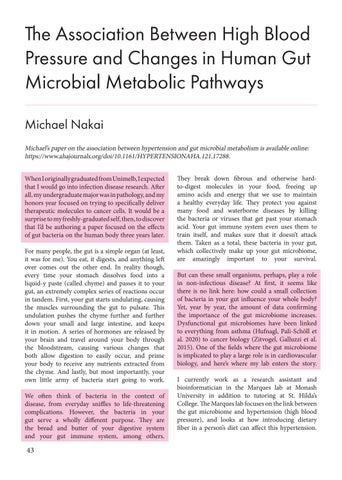The Association Between High Blood Pressure and Changes in Human Gut Microbial Metabolic Pathways Michael Nakai Michael’s paper on the association between hypertension and gut microbial metabolism is available online: https://www.ahajournals.org/doi/10.1161/HYPERTENSIONAHA.121.17288. When I originally graduated from Unimelb, I expected that I would go into infection disease research. After all, my undergraduate major was in pathology, and my honors year focused on trying to specifically deliver therapeutic molecules to cancer cells. It would be a surprise to my freshly-graduated self, then, to discover that I’d be authoring a paper focused on the effects of gut bacteria on the human body three years later. For many people, the gut is a simple organ (at least, it was for me). You eat, it digests, and anything left over comes out the other end. In reality though, every time your stomach dissolves food into a liquid-y paste (called chyme) and passes it to your gut, an extremely complex series of reactions occur in tandem. First, your gut starts undulating, causing the muscles surrounding the gut to pulsate. This undulation pushes the chyme further and further down your small and large intestine, and keeps it in motion. A series of hormones are released by your brain and travel around your body through the bloodstream, causing various changes that both allow digestion to easily occur, and prime your body to receive any nutrients extracted from the chyme. And lastly, but most importantly, your own little army of bacteria start going to work. We often think of bacteria in the context of disease, from everyday sniffles to life-threatening complications. However, the bacteria in your gut serve a wholly different purpose. They are the bread and butter of your digestive system and your gut immune system, among others.
43
They break down fibrous and otherwise hardto-digest molecules in your food, freeing up amino acids and energy that we use to maintain a healthy everyday life. They protect you against many food and waterborne diseases by killing the bacteria or viruses that get past your stomach acid. Your gut immune system even uses them to train itself, and makes sure that it doesn’t attack them. Taken as a total, these bacteria in your gut, which collectively make up your gut microbiome, are amazingly important to your survival. But can these small organisms, perhaps, play a role in non-infectious disease? At first, it seems like there is no link here: how could a small collection of bacteria in your gut influence your whole body? Yet, year by year, the amount of data confirming the importance of the gut microbiome increases. Dysfunctional gut microbiomes have been linked to everything from asthma (Hufnagl, Pali-Schöll et al. 2020) to cancer biology (Zitvogel, Galluzzi et al. 2015). One of the fields where the gut microbiome is implicated to play a large role is in cardiovascular biology, and here’s where my lab enters the story. I currently work as a research assistant and bioinformatician in the Marques lab at Monash University in addition to tutoring at St. Hilda’s College. The Marques lab focuses on the link between the gut microbiome and hypertension (high blood pressure), and looks at how introducing dietary fiber in a person’s diet can affect this hypertension.









